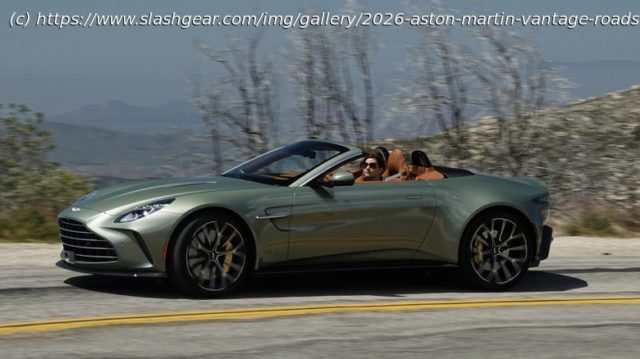No afterthought, the Vantage Roadster may lack its coupe cousin’s roof, but time behind the wheel shows it sparkles in unexpected ways.
The average sports car buyer might think that, because coupes always hit the market before convertibles, the coupe also comes first in the development process. Yet on every media launch program, automakers always insist that the entire model lineup plan always included a convertible from the get-go. And no surprise there, since modern machines can’t just chop the top off, and instead require years of engineering before actually hitting dealer floors.
In fairness, convertibles have taken big strides over the past few years, as retractable hard tops, weight savings, and easy operation all made the prospect of open-top motoring all the more palatable. But I’m still—unabashedly—not a convertible guy. In fact, there’s only one car that I’ve ever preferred as a convertible: the Maserati MC20 Cielo. And even the Cielo was really more of a Targa, while the reason I actually liked it more than the coupe that preceded it was because Maserati attempted to recoup lost rigidity by using a different carbon layup for the monocoque, which then allowed for much softer suspension settings (while only sacrificing the engine bay’s view in the meantime).
More typically, I hate convertibles because I love climate control, don’t enjoy excessive wind and tire noise, and typically believe that designs I like tend to get ruined. The latter, however, certainly does not apply to Aston Martin’s new Vantage Roadster. Early press pics revealed an absolutely stunning convertible that sacrifices none of the class and muscularity of the coupe, from just about any angle. So I gladly took up Aston Martin’s offer to host me on a recent media drive program, curious to learn whether I could live with this latest convertible given the amount of sun that toasted my face on the high-speed roads around the deserts and mountains of Palm Springs.Remembering the Vantage coupe
I loved the Vantage coupe when I took a loaner last year. Spicy and sexy and ridiculously raucous, the Vantage borders on true exotic supercar status despite its $191,000 starting price tag coming in below a 911 Turbo. More recently, a friend also let me go for a spin in a 2006 V8 Vantage, which then put Aston’s enormous strides over the past two decades into even better perspective. And surprise surprise, as Aston Chief Creative Officer Marek Reichman presented his latest masterpiece in person, he emphasized that the plan for this generation always included a Roadster variant (though why it’s not officially dubbed a Volante, I cannot confirm).
But I caught up with Reichman later in the day, hoping to dive deeper into a little comment he made that morning. Specifically, he said the Roadster design actually came first—something I’ve never heard another OEM representative confirm, in my admittedly limited experience with convertible launches.Investment strategy dictates design and engineering
„When you start your investment“, Reichman told me, „We always start with the convertible, ‚cause it’s the most complex in terms of engineering and getting the chassis stiff. That’s by intention. So it’s not concurrent, it’s first.“
This strategy makes sense especially in today’s era of overwhelming power and the unbelievable chassis stiffness needed to harness the grip of modern tires. Why not start with a solid base for a convertible, then only make it better for the simpler coupe? And the Vantage Roadster’s lines still stay strong, yet somehow sleeker than the more aggressive coupe—with both the top up and down.
Start
United States
USA — IT 2026 Aston Martin Vantage Roadster First Drive: The Car They Meant To...






